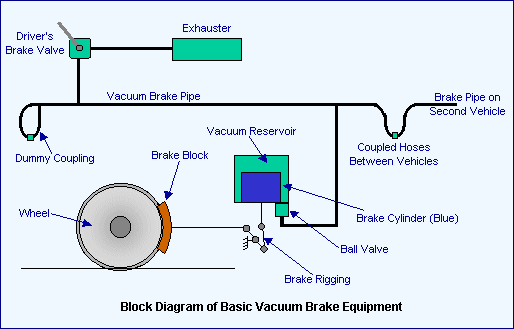





Published on Nov 30, 2023
The vacuum brake was, for many years, used in place of the air brake as the standard, fail-safe, train brake used by railways. Pneumatic braking systems use compressed air as the force used to push blocks on to wheels.The vacuum brake system is controlled through a brake pipe connecting a brake valve in the driver's cab with braking equipment on every vehicle.A vacuum is created in the pipe by an ejector or exhauster.
The ejector removes atmospheric pressure from the brake pipe to create the vacuum using steam on a steam locomotive, or an exhauster, using electric power on other types of train. With no vacuum the brake is fully applied. The vacuum in the brake pipe is created and maintained by a motor-driven exhauster. The exhauster has two speeds, high speed and low speed.
The high speed is switched in to create a vacuum and thus release the brakes . slow speed is used to keep the vacuum at the required level to maintain brake release. vacuum against small leaks in the brake pipe is maintained by it.

driver controls the brake using this. It has the following positions: "Release", "Running", "Lap" and "Brake On"."Neutral" or "Shut Down" positions are also available which locks the valve out of use. he "Release" position connects the exhauster to the brake pipe and switches the exhauster to full speed. This raises the vacuum in the brake pipe as quickly as possible to get a release. the exhauster keeps running but at its slow speed in the "Running" position.
This ensures that the vacuum is maintained against any small leaks or losses in the brake pipe, connections and hoses."Lap" is used to shut off the connection between the exhauster and the brake pipe to close off the connection to atmosphere after a brake application has been made."Brake On" closes off the connection to the exhauster and opens the brake pipe to atmosphere.
A two-speed rotary machine fitted to a train to evacuate the atmospheric pressure from the brake pipe, reservoirs and brake cylinders to effect a brake release.
a dummy coupling point is provided At the ends of each vehicle to allow the ends of the brake pipe hoses to be sealed when the vehicle is uncoupled.
The brake pipe is carried between adjacent vehicles through flexible hoses.
a vacuum reservoir is provided on, or connected to the upper side of the piston to ensure there is always a source of vacuum available to operate the brake.
The movement of the piston contained inside the cylinder operates the brakes through links called "rigging".
the movement of the brake cylinder piston transmits pressure to the brake blocks on each wheel through this system.
the friction material which is pressed against the surface of the wheel tread by the upward movement of the brake cylinder piston.
The ball valve is needed to ensure that the vacuum in the vacuum reservoir is maintained at the required level, i.e. the same as the brake pipe, during brake release but that the connection to the brake pipe is closed during a brake application.